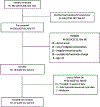Influence of menstrual cycle and hormonal contraceptive use on MS symptom fluctuations: A pilot study
- PMID: 37480738
- PMCID: PMC11090415
- DOI: 10.1016/j.msard.2023.104864
Influence of menstrual cycle and hormonal contraceptive use on MS symptom fluctuations: A pilot study
Abstract
Background: In clinical practice, females with MS often report menstrually-related symptom fluctuations. Hypothetically, use of oral contraceptives (OCs) could reduce these fluctuations, particularly continuous OCs (11+ weeks of consistent exogenous hormones followed by 1 week placebo).
Objectives: To prospectively capture (1) whether neurologic and generalized symptoms vary with menstrual cycle phase and (2) whether type of contraception impacts symptom fluctuations.
Methods: In this two-center pilot study, females with MS and a regular menstrual cycle prospectively tracked their menstrual cycles and completed symptom surveys for up to 6 months. Participants were categorized as 1) users of oral contraceptives, either a) cyclic or b) continuous, or 2) endogenously cycling, either c) hormonal intrauterine device (IUD) users or d) "none users" (e.g. no hormonal contraception; included condoms, copper IUD, tubal ligation, "fertility awareness methods"). There was no correction for multiple analyses.
Results: Altogether, 47/70 participants (67%) provided >4 weeks of data and were included in the analyses. Mean (SD) age was 35.0 (0.9) years, median (IQR) EDSS was 1.5 (1-2) and mean (SD) SymptoMScreen score was 10.4 (9.6). For endogenously cycling patients (IUD and none users), fatigue (MFIS) was lower in the perimenstrual period than in the luteal period (p < 0.05). For continuous OC users, variability in symptoms was lower than for endogenously cycling females (MFIS: p < 0.01; Daily Hassles, from Uplift & Hassles Survey: p < 0.05) or cyclic OC users (MFIS: p < 0.001).
Conclusions: In this pilot study, symptom severity did not definitively fluctuate in relationship to the menstrual cycle in endogenously cycling participants. However, fatigue and daily hassles were less variable for participants using continuous OC than for cyclic OC users or no-OC users. Future confirmatory studies are warranted to further examine whether contraceptive choice can be leveraged to manage symptom fluctuation in cycling females with MS. Such studies could enroll larger cohorts over fewer cycles or employ incentivization and hormonal measurements to enhance participant retention and statistical power.
Keywords: Contraception; Estrogen; Hormone; Menstrual cycle; Multiple sclerosis; Symptom.
Copyright © 2023. Published by Elsevier B.V.
Conflict of interest statement
Declaration of Competing Interest Helga Taylor, Saleh Alhasan, Maha Saleem(,) Shane Poole, Fei Jiang report no disclosures. Erin E. Longbrake has received research support from Genetech, NIH. She has received consulting or advisory board fees from Genentech, Janssen, TG Therapeutics, NGM Bio, Bristol Myers Squibb, EMD Serono and Genzyme. Riley Bove is supported by a National Multiple Sclerosis Society Harry Weaver Award. She receives research support from NIH, NSF, Department of Defense, National Multiple Sclerosis Society, as well as from Biogen, Novartis and Roche Genentech. She also reports scientific advisory board and consulting fees from Alexion, EMD Serono, Horizon, Genzyme Sanofi, Janssen, and TG Therapeutics.
Figures



Similar articles
-
Cyclic fluctuations in human serum lipid and apolipoprotein levels during the normal menstrual cycle: comparison with changes occurring during oral contraceptive therapy.Metabolism. 1991 Aug;40(8):849-54. doi: 10.1016/0026-0495(91)90014-n. Metabolism. 1991. PMID: 1907348
-
Comparison of MS inflammatory activity in women using continuous versus cyclic combined oral contraceptives.Mult Scler Relat Disord. 2020 Jun;41:101970. doi: 10.1016/j.msard.2020.101970. Epub 2020 Feb 6. Mult Scler Relat Disord. 2020. PMID: 32088652
-
The secretion of human chorionic gonadotropin-like substance in women employing contraceptive measures.J Clin Endocrinol Metab. 1984 Apr;58(4):646-53. doi: 10.1210/jcem-58-4-646. J Clin Endocrinol Metab. 1984. PMID: 6699130
-
Menstrual impact of contraception.Am J Obstet Gynecol. 1994 May;170(5 Pt 2):1513-22. doi: 10.1016/s0002-9378(94)05013-1. Am J Obstet Gynecol. 1994. PMID: 8178900 Review.
-
Fertility after contraception or abortion.Fertil Steril. 1990 Oct;54(4):559-73. doi: 10.1016/s0015-0282(16)53808-4. Fertil Steril. 1990. PMID: 2209874 Review.
Cited by
-
Hormonal Therapies in Multiple Sclerosis: a Review of Clinical Data.Curr Neurol Neurosci Rep. 2024 Jan;24(1):1-15. doi: 10.1007/s11910-023-01326-7. Epub 2023 Dec 16. Curr Neurol Neurosci Rep. 2024. PMID: 38102502 Free PMC article. Review.
References
-
- Bove R, Chitnis T, 2014. The role of gender and sex hormones in determining the onset and outcome of multiple sclerosis. Mult. Scler. 20 (5), 520–526. Apr. - PubMed
-
- Chen CS, Krishnakumar T, Rowles W, Anderson A, Zhao C, Do L, et al., 2020. Comparison of MS inflammatory activity in women using continuous versus cyclic combined oral contraceptives. Mult. Scler. Relat. Disord. 41, 101970. Jun. - PubMed
-
- Cooper DB, Patel P, Mahdy H, 2022. Oral contraceptive pills. StatPearls [Internet]. StatPearls Publishing, Treasure Island (FL) [cited 2022 Sep 8]. Available from. http://www.ncbi.nlm.nih.gov/books/NBK430882/. - PubMed
-
- De Leo V, Scolaro V, Musacchio MC, Di Sabatino A, Morgante G, Cianci A, 2011. Combined oral contraceptives in women with menstrual migraine without aura. Fertil. Steril. 96 (4), 917–920. Oct. - PubMed
-
- DeLongis A, Coyne JC, Dakof G, Folkman S, Lazarus RS, 1982. Relationship of daily hassles, uplifts, and major life events to health status. Health Psychol. 1, 119–136.

